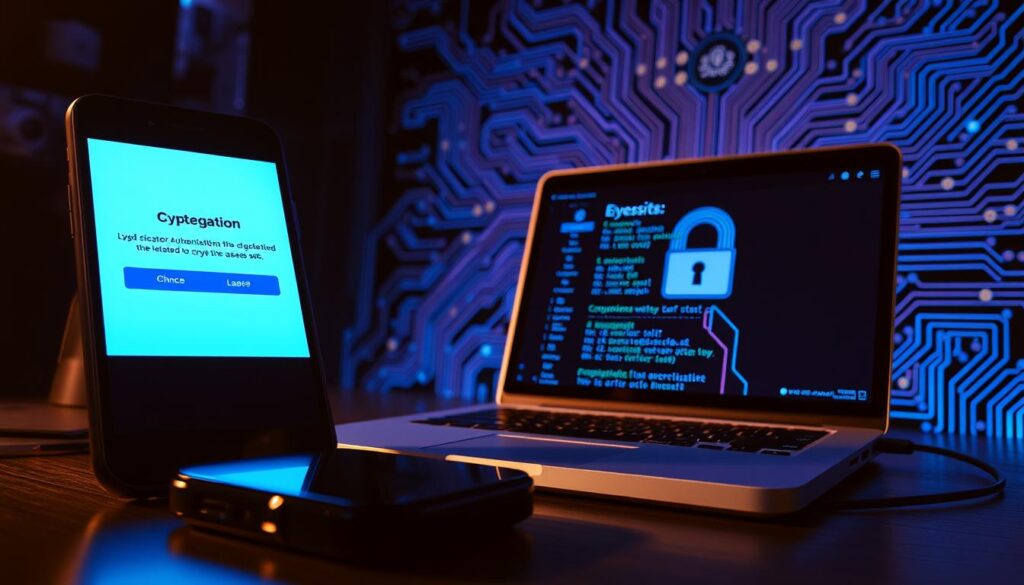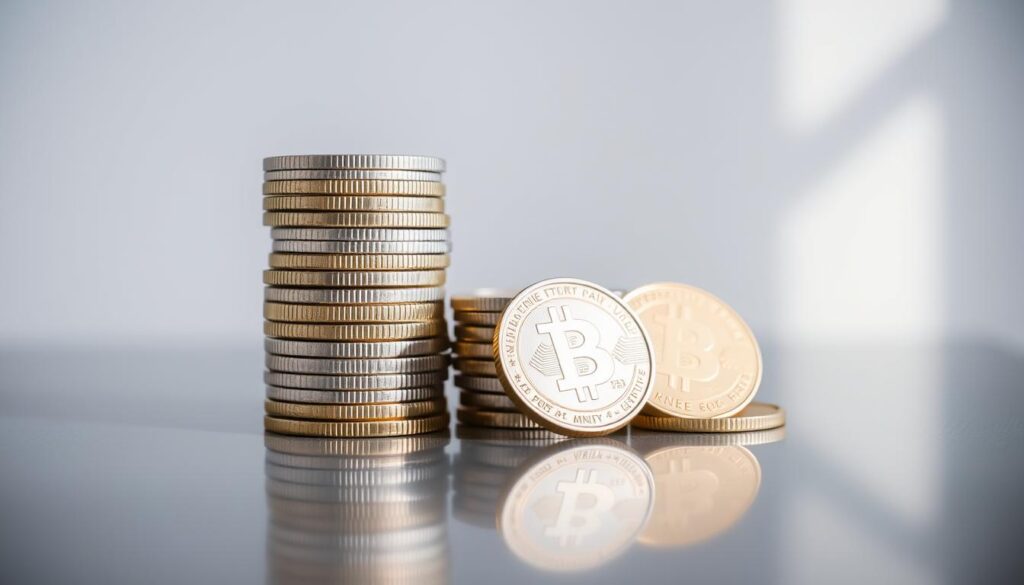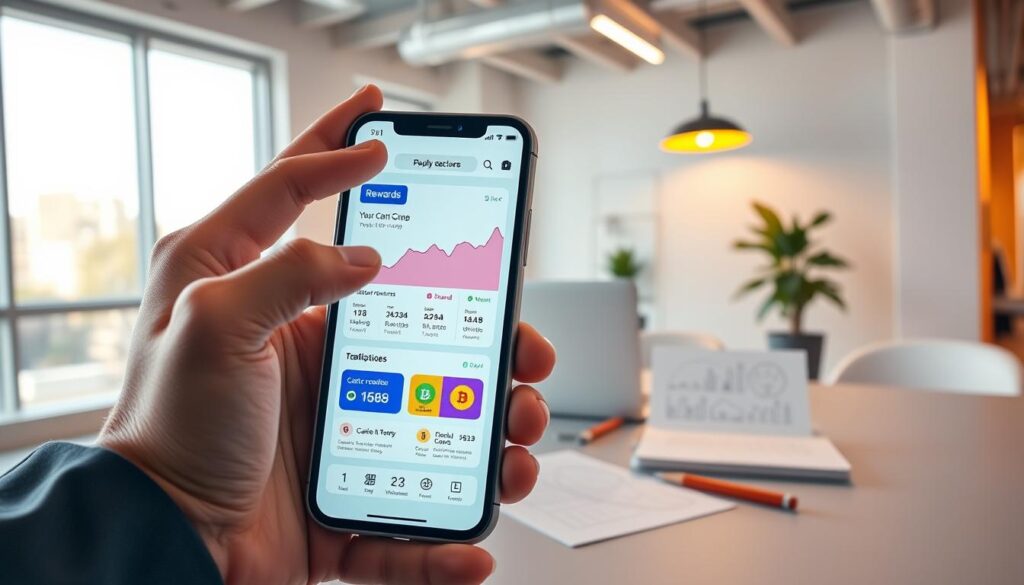Now Reading: Protect Your Digital Assets: Crypto Security Tips for Americans
- 01
Protect Your Digital Assets: Crypto Security Tips for Americans
Protect Your Digital Assets: Crypto Security Tips for Americans

Cryptocurrency security is not optional—it’s essential. As more people use crypto, threats like hacking and scams grow. Knowing how to protect your digital assets is key to avoiding big losses.
Cybercriminals are targeting American investors with sophisticated attacks. These include exchange breaches and social engineering scams. These attacks cost users millions each year. By following crypto security tips, you can avoid becoming a victim of fraud.
Key Takeaways
- Crypto security mistakes lead to permanent financial damage.
- Cyber threats against U.S. crypto users are escalating rapidly.
- Proper best practices for crypto security reduce exposure to theft.
- Hardware wallets and two-factor authentication are critical defenses.
- Ignoring security guidelines risks losing all stored digital assets.
Understanding the Crypto Security Landscape in 2023
Crypto security is key as more people use digital money. Keeping your digital money safe means dealing with new threats and local issues. Cybercriminals are focusing on U.S. users because of valuable assets and special weaknesses.
Common Threats Targeting American Crypto Holders
Criminals use many ways to attack: phishing emails, SIM swapping to take over accounts, and malware that gets into devices. In 2023, over $1 billion was lost worldwide due to exchange hacks.
Why Americans Face Unique Security Challenges
U.S. users are at risk because they hold a lot of crypto and the dollar is big in trading. Rules like IRS reporting make things more complicated. Finding a balance between being open and keeping your crypto safe is crucial.
The Rising Cost of Security Breaches
The financial losses are huge. A 2023 Chainalysis report showed U.S. victims lost an average of $1.2 million per big breach. These numbers highlight the need for quick action to protect your digital money from big financial losses.
Best Practices for Crypto Security for American Users
Protecting your cryptocurrency investments starts with adopting proven best practices for crypto security for American users. These strategies create a shield against cyber threats while adapting to your investment scale. A layered approach, like locking doors and alarms in a house, combines physical, digital, and behavioral safeguards.
- Hardware wallets for storing large holdings: Cold storage devices like Ledger or Trezor keep keys offline.
- Two-factor authentication (2FA) on all accounts: Enable Google Authenticator or Authy for exchanges and wallets.
- Limit exchange balances: Move funds to personal wallets instead of leaving them on platforms like Coinbase or Binance.
- Regular updates: Patch software, firmware, and apps to block exploit vulnerabilities.
- Secure seed storage: Split seed phrases into locked safes or use tamper-proof vaults like Fireproof Safe models.
Education is critical. Stay informed about phishing tactics targeting U.S. taxpayers and monitor IRS guidelines for tax reporting. Smaller investors can start with basic measures, while larger portfolios require advanced steps like multi-signature setups. Every layer adds value—no single step can guarantee 100% safety, but combined practices reduce risks significantly.
Creating an Impenetrable Account Security Strategy
Building a strong crypto security framework starts with securing your core accounts. These cryptocurrency security tips help keep hackers out. Follow these steps to protect your crypto assets well.
Strengthening Your Exchange Account Credentials
Passwords are your first defense. Use passwords with 12+ characters, mixing letters, numbers, and symbols. Never use the same password for different sites. Tools like LastPass or 1Password can help create and store unique passwords.
Make sure to enable two-factor authentication on all exchanges. This simple step can block 99% of unauthorized access attempts.
Email Security as Your First Line of Defense
Email accounts are often targeted by attackers. Enable 2FA for all email providers and have a separate inbox for crypto activities. Don’t link your main email to exchanges. Use encrypted email services like ProtonMail for sensitive messages.
These top security practices for crypto users help prevent recovery code hijacking. This is a common way hackers get into accounts.
Social Engineering Defense Tactics
Scammers pretend to be from exchanges or regulators to steal your login details. Never click on links in emails without checking them first. Always type URLs yourself. Verify any requests for withdrawals by voice call, not through contact info provided.
Report any suspicious messages right away. Learning to pause and verify every request can stop 80% of social engineering attacks.
Hardware Wallets: Your Ultimate Security Investment
Hardware wallets are the top choice for secure crypto storage methods for serious investors. They keep private keys offline, away from threats like malware or phishing. Brands like Ledger, Trezor, and KeepKey offer features for different user needs.
- Ledger: Supports over 5,000 cryptocurrencies with a user-friendly interface.
- Trezor: Military-grade encryption and open-source firmware for transparency.
- KeepKey: Physical keypad to prevent screen-phishing attacks.
These wallets use air-gapped technology, never connecting to the internet. This means no remote hacking risks. Buy wallets from official retailers to avoid fakes. Use a strong PIN and update firmware often to stay safe.
Backup procedures are key. Store recovery phrases offline, never digitize them. If a device is lost or damaged, use the seed phrase to regain access. Investing in hardware wallets is a crucial step in how to secure your crypto assets for the long term.
Software Wallets: Balancing Convenience and Security
Software wallets are popular for everyday crypto use. But, they need careful crypto wallet security tips. Keeping your Bitcoin and altcoins safe is key, without losing ease of use.
Mobile Wallet Security Considerations
- Enable biometric authentication on iOS or Android devices.
- Restrict app permissions to only those required for wallet function.
- Update operating systems and wallet apps immediately to patch vulnerabilities.
Desktop Wallet Protection Measures
Desktop users should focus on:
- Full-disk encryption for all devices storing wallet data.
- Regularly updated antivirus software to block crypto-mining malware.
- Use dedicated virtual machines for critical transactions.
Browser Extension Wallet Safeguards
Browser extensions like MetaMask need extra care:
- Never grant blanket access to unverified websites.
- Enable phishing protection features in wallet settings.
- Avoid using extensions on public or shared computers.
By following these steps, you can keep your Bitcoin and altcoins safe. Stay updated, manage permissions, and control your environment. This way, you can enjoy convenience without risking security.
The Critical Role of Two-Factor Authentication
Two-factor authentication (2FA) is key to best practices for crypto security. For Americans, turning on 2FA blocks unauthorized access. Every crypto exchange and wallet must have it, but not all 2FA is the same.

- SMS-based 2FA: Stay away from SMS codes because of SIM swapping attacks. These are common in the U.S., where hackers take over phone numbers.
- Authenticator apps: Choose apps like Google Authenticator or Authy for TOTPs. These apps are free and hard to hack.
- Hardware keys: Get FIDO2-certified devices like YubiKey or Google Titan Security Key. They stop phishing and remote attacks completely.
Setting up 2FA on sites like Coinbase, Kraken, or Binance.US is quick. Just go to account settings, pick your method, and save backup codes in a safe place. If you lose your phone, recovery codes help you get back in without losing your crypto.
New tech like biometric login (e.g., fingerprint) and U2F protocols make security better. Using these crypto security measures cuts down on breaches by over 99% compared to just passwords. The effort to set up 2FA is worth it to protect your crypto assets.
Mastering the Art of Private Key Management
Private keys unlock your crypto assets. To keep your digital currency safe, you must learn about key management. This includes understanding private keys, public keys, and seed phrases.
Secure storage starts with keeping things physical. Seed phrases should never be digital only. Options like Cryptosteel metal plates or Billfodl cases are great for storing them safely.
Store these in home safes or bank safety deposit boxes for extra security. Always avoid digital storage, as cloud drives and smartphones are risky.
- Use non-digital methods for seed phrases
- Split storage across multiple physical locations
- Avoid photographing or emailing seed phrases
Having a recovery plan is key to avoiding loss. Keep important details in a waterproof safe deposit box. Share access instructions with trusted family via encrypted files.
Include crypto assets in your estate plans. Make sure legal documents follow U.S. inheritance laws. Update these plans every year so heirs can access assets legally.
Securing your crypto assets needs careful key management. Use physical safeguards and legal planning to keep assets safe. Never trust digital methods alone—your keys are your last defense.
Cold Storage Solutions for Long-Term Hodlers
Cold storage is key for secure crypto storage methods for long-term holders. Americans use both physical and technical ways to protect their wealth. This keeps it safe from digital threats and physical dangers.
- Air-Gapped Systems: Use offline computers for wallet generation to prevent malware exposure.
- Paper Wallets: Print seed phrases on fireproof, waterproof materials stored in safe deposit boxes.
- Multisig Solutions: Distribute control across multiple hardware wallets or trusted parties to reduce single-point failure risks.
Geographic redundancy is important. Keep backups in climate-controlled home safes, bank vaults in low-flood zones like Denver, and international storage in stable places. Services like Casa and Unchained Capital offer top-notch vaulting for big portfolios. They also help with legal inheritance to avoid probate issues.
Regular checks are vital. Do small test transfers yearly to make sure you can get to your money. Keep physical backups in different places—never in one spot that’s prone to disasters. This mix of technical and geographic diversification keeps your assets safe and ready when you need them.
Securing Your Crypto While Actively Trading
Active traders need crypto security measures that fit their fast-paced trading style. It’s important to find a balance between easy access and strong protection. This balance helps reduce risks without slowing down trading.

Exchange Security Best Practices
Opt for exchanges like Coinbase or Binance.US, known for their strong security. Make sure to use whitelisted withdrawal addresses and set time locks on withdrawals. This blocks unauthorized transfers. For API users, limit API key permissions and change them often. These steps are key for top security practices for crypto users who trade every day.
Limiting Risk Through Smart Trading Habits
Here are some ways to lower your risk:
- Only keep money meant for trading on exchanges; store long-term funds in cold wallets
- Use scheduled withdrawals to move extra funds to offline storage
- Spread your assets across different exchanges to avoid losing everything at once
This method helps protect you while still letting you take advantage of market chances.
Network Security for Mobile Traders
Keeping your digital life safe means:
- Always use a trusted VPN like ExpressVPN when you’re online
- Avoid doing sensitive stuff on public Wi-Fi
- Turn off location services on your trading apps
Traders with a lot of money, especially in places like Silicon Valley or NYC, need to be even more careful.
Identifying and Avoiding Cryptocurrency Scams
Keeping your digital currency safe from scams is crucial. In the U.S., over $1 billion was lost to crypto fraud in 2023. Scammers use social media, email, and even fake celebrity endorsements to trick people.
Common scams to watch for include:
- Investment frauds promising “guaranteed returns” with no risk
- Giveaway scams demanding payment upfront for promised rewards
- Fake customer support claiming account “verification” fees
- Romance scams where scammers build relationships to steal funds
Be cautious of urgent demands, unsolicited contact, and pressure to skip two-factor authentication. Never give out your seed phrases or private keys.
To stay safe, check if projects are real through the SEC’s Investor Bulletins and CFTC’s fraud alerts. If something seems off, report it to the FBI’s IC3 portal (ic3.gov). Always double-check URLs for any misspellings in crypto exchange links.
Being skeptical is key to protecting your digital currency. Use the FTC’s ReportFraud.gov to report scams. Also, check project histories with Onchain Analysis Tools. Don’t invest based on social media hype alone—do your research on the team, code, and regulatory compliance.
Regulatory Compliance and Tax Security for US Citizens
Following tax laws and federal rules is key to keeping your Bitcoin and altcoins safe. It’s important to report correctly and protect your data. This way, you can keep your investments safe and avoid legal trouble. Here’s how to follow the rules and keep your digital assets secure.
IRS Reporting Requirements for Crypto Assets
The IRS sees crypto as property, so you must report sales, trades, and rewards. You need to:
- Report capital gains from selling Bitcoins or trading them
- Declare income from mining or staking crypto
- Track fork events and airdrops as taxable events
New rules like the Infrastructure Act’s exchange reporting rules (learn more here) require accurate records to avoid audits.
Secure Record-Keeping for Tax Purposes
Keep your transaction logs safe with encrypted software like crypto trackers (including cashback rewards). Follow these tips:
- Store offline backups in secure hardware wallets
- Only allow trusted platforms to access your API
- Check your transaction history regularly
Protecting Your Data During Tax Filing
When filing taxes, protect your data by:
- Using encrypted tax software
- Sharing documents securely with CPAs who know about crypto
- Deleting temporary files after filing
Following the rules helps avoid legal problems that could risk your assets. It keeps your investments safe for the long term.
Crypto Insurance Options Available to Americans
Crypto insurance is becoming more common to help protect how to secure your crypto assets. In the U.S., companies like Coinbase and Gemini offer some coverage. This is for users who have been hacked or if the company fails.
For example, Coinbase’s Insurance Program covers USD deposits up to $250,000. But, it doesn’t cover crypto. Always check the policy to see what’s not covered, like losing your private key or falling for a scam.

- Exchange-Backed Coverage: Platforms like Gemini provide custodial insurance, but check coverage caps and excluded scenarios.
- Dedicated Crypto Insurers: Companies like Etherisc and Lemonade now offer policies for retail investors, with premiums based on asset size and risk exposure.
- Institutional Options: High-net-worth individuals may qualify for custodial insurance through firms like Arch Specialty, covering physical storage and cyber risks.
Self-insurance strategies like diversifying assets across cold storage and exchanges also reduce risk. Misconceptions persist: no policy covers losses from personal negligence, such as sharing seed phrases. Always pair insurance with best practices for crypto security, including hardware wallets and two-factor authentication. Regularly update policies to match portfolio growth and evolving threats.
Insurance alone cannot replace proactive measures like secure backups or scam awareness. Use it as one layer in a broader strategy, not a standalone solution. Research providers thoroughly and verify state compliance before purchasing.
Travel Security: Protecting Your Assets While on the Move
Traveling with crypto requires extra care to avoid theft or loss. Follow these crypto wallet security tips to stay safe on trips, whether at home or abroad.
- Adjust exchange withdrawal limits to reduce risks of unauthorized transactions.
- Notify custodial services of travel dates to flag suspicious activity automatically.
- Disable biometric logins on devices to prevent forced access at borders.
Carry hardware wallets in tamper-evident cases and avoid charging devices via public ports. Use a travel phone for crypto apps only, never mixing it with personal data. Before crossing borders, store seed phrases in encrypted cloud backups or secure physical containers. U.S. customs officials may ask about digital assets—refuse to disclose private keys and invoke the Fifth Amendment if pressured.
When accessing crypto apps, avoid hotel Wi-Fi. Opt for a mobile hotspot from providers like Verizon or T-Mobile for safer internet. Enable multi-factor authentication on all accounts, even for temporary devices. Carry a paper backup of recovery phrases in a separate location from hardware wallets.
Follow these cryptocurrency security tips to prepare for emergencies: register emergency contacts with custodial services and memorize critical recovery information. Review Forbes’ custody guidelines for additional strategies. Stay vigilant—travel-specific threats demand proactive planning to protect your crypto holdings.
Staying Ahead: Security Update Protocols for Your Crypto Stack
Keeping your crypto safe is a constant job. Top security practices for crypto users mean always being on guard. Regular updates and watching for threats are crucial for securing your Bitcoin and altcoins for the long haul.
Wallet Firmware Update Best Practices
Hardware wallets like Ledger or Trezor need regular updates. Here’s how to do it right:
- Check manufacturer websites directly for update notices
- Verify checksums provided by developers to confirm authenticity
- Backup recovery phrases before updating
- Update only on secure, offline devices
Exchange Security Announcement Monitoring
Keep up with risks from places like Coinbase or Binance. Subscribe to:
- Official security newsletters
- Exchange blog updates
- Twitter/X alerts from trusted providers
Always check links through official websites to dodge phishing scams.
Security Audit Tools for Personal Checks
Use tools like MyCrypto’s security scanner or blockchain explorers to:
- Check wallet address integrity
- Scan for suspicious transactions
- Run configuration checks monthly
Tools like Chainalysis React help spot threats in real-time. They make sure your setup is up to date.
Building Your Personal Crypto Security Framework for Long-Term Protection
Protecting your cryptocurrency investments needs a plan that grows with you. Start by looking at your portfolio size, how public you are, and the risks you face. Beginners should use two-factor authentication and hardware wallets.
Intermediate users can add cold storage and regular security checks. Advanced users might use multi-signature systems and biometric security.
It’s important to keep things simple. Start with the basics, then add more as your investments grow. Always update your software and watch for security alerts from exchanges.
American users should keep up with new encryption and tax rules. Tools like Ledger’s updates or Trezor’s audits are useful steps. Even small portfolios need a recovery plan and safe seed phrase storage.
This plan isn’t set in stone. Check and update it every quarter to stay safe. By matching your security to your needs, you build a strong defense. Start now to protect your digital wealth for the future.
FAQ
What are the best practices for crypto security?
For crypto security, use strong, unique passwords and enable two-factor authentication. Regularly update your software and use hardware wallets for storage. Also, educate yourself about scams and phishing attempts.
It’s key to use a layered security approach to protect your investments.
How can I secure my crypto assets effectively?
Secure your crypto assets by using hardware wallets for long-term storage. For everyday transactions, use secure software wallets. Keep sensitive information offline.
Practice regular backups and have a recovery plan ready.
What are secure storage methods for cryptocurrency?
Secure storage for cryptocurrency includes hardware wallets and cold storage solutions. Avoid storing seed phrases or private keys in digital formats.
What are some cryptocurrency security tips I should follow?
Keep your devices updated and use reputable wallets. Enable two-factor authentication and be cautious with emails. Monitor your accounts for unusual activity.
Stay updated on the latest threats and scams targeting crypto users.
How do I protect my cryptocurrency investments?
Protect your investments by using hardware wallets for cold storage. Apply strong security measures on exchanges. Limit funds in hot wallets and watch out for phishing attempts.
Diversify your investments to reduce risk.
What additional security measures can I take when using exchange platforms?
On exchange platforms, use whitelisting and enable withdrawal time locks. Use two-factor authentication and monitor your account activity. Only keep what you need for trading on exchanges.
What are the security risks involved in storing cryptocurrencies on exchanges?
Storing cryptocurrencies on exchanges risks hacks, theft, and insolvency. Cybercriminals target exchanges due to wealth concentration. Move funds to secure wallets when not trading.
How can I ensure the safety of my private keys?
Store your private keys in a secure, offline environment like a hardware wallet. Avoid digital copies on cloud services or internet-connected devices.
What is the role of two-factor authentication in crypto security?
Two-factor authentication (2FA) adds a security layer beyond passwords. It significantly reduces unauthorized access to your crypto accounts, especially on exchanges.
Are there crypto insurance options available for Americans?
Yes, Americans have crypto insurance options. These include exchange-provided insurance and dedicated crypto insurance products. Read the fine print and understand coverage limits.














